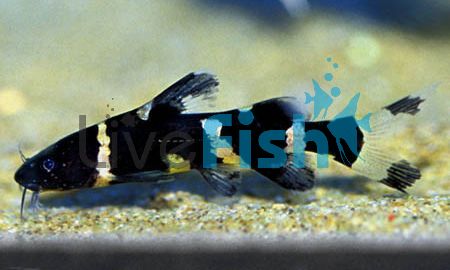Bumble Bee Catfish 4cm
Catfish are always a top-of-the-list species in the aquarium hobby. Given that there are so many different species ranging from the common and loved options such as corydoras to the real oddball end like Raphael, there seems to be a species for everyone. The bumblebee catfish will most likely appeal to the oddball collectors in the aquarium hobby as this is not a fish seen all that common in the Australian industry.
- Buy 5 for $33.23 each and save 10%
- Buy 10 for $29.54 each and save 20%
Bumblebee Catfish
Catfish are always a top-of-the-list species in the aquarium hobby. Given that there are so many different species ranging from the common and loved options such as corydoras to the real oddball end like Raphael, there seems to be a species for everyone. The bumblebee catfish will most likely appeal to the oddball collectors in the aquarium hobby as this is not a fish seen all that common in the Australian industry.
The Bumble Bee Catfish have a real ghostly look to them. Their body colour is a true jet black that almost reflects no light, when these fish hide in a cave, they almost look invisible. The only slight area of contrast is the light-yellow banding through the catfish that earns them their name. Since the bumblebee catfish reach around 17 cm, they are quite large fish but remain very slender almost giving them a reptile-like appearance. They also stick true to the catfish title by sporting the classic barbels at the front of their face as well.
the bumblebee catfish has not actually been bred in the home aquarium. This is most likely because of the specific environmental needs this fish requires, which is hard to replicate in the home aquarium. There are also no distinguishing factors between males and females which makes the process even harder. The bumblebee catfish has a fairly large geographical range since it is found in Thailand, Vietnam, Laos, and Cambodia.
Tank Recommendations for your Bumblebee Catfish
The Bumble Bee Catfish does get to a maximum size of around 15 cm but they are a very inactive fish. This species often spends most of its time hiding in caves or driftwood and prefers to be nocturnal. For this reason, a minimum aquarium volume of 200 liters would be fine however larger aquariums will not hurt.
Bumblebee catfish come from slow-moving waters that contain a lot of vegetation, botanicals, and organic matter. These environments often have low visibility and sport a black water look. Replicating something like this will be beneficial as it will make the catfish feel more comfortable and may entice it to spend more time in the open.
Suitable Tank Buddies
The Bumble Bee Catfish are actually quite peaceful, they are not active hunters but scavengers. It is however best to avoid keeping any fish that is smaller than their mouth, as these would be an easy meal.
Usually Compatible
Mystus catfish, Raphael catfish, giant danio, angelfish, and larger but peaceful community fish species.
Sometimes Compatible
Larger, semi-aggressive cichlid species as these fish can easily injure the scaleless bumblebee catfish. Species like Oscar may even try to make a potential meal out of the catfish so caution should be taken.
Rarely Compatible
Shrimp and nano aquarium fish like neon tetras, and ember tetras which will become an easy meal for the bumblebee catfish.
Feeding your Bumblebee Catfish
As reclusive as these fish are, they should take to aquarium foods quite easily. It may be good to try out some frozen foods to ensure these fish are definitely eating after they have been added into the tank. They can then be fed a good quality sinking pellet food for optimal nutrition.
| Scientific Name | Pseudomystus Siamensis |
|---|---|
| Care Level | Moderate |
| Common Names | Bumblebee catfish, asian bumblebee catfish |
| Diet | Carnivore |
| Fish Family | Bagridae |
| Lifespan (years) | 6 |
| Max. Length (cm) | 15 |
| Min. Tank Volume (l) | 470 Litres |
| Origin | Asia |
| Reef Safe | With Caution |
| Sociability | Peaceful |
| Venomous | No |
| Water Conditions | 24-26° C, pH 5.5.-7.0 |




